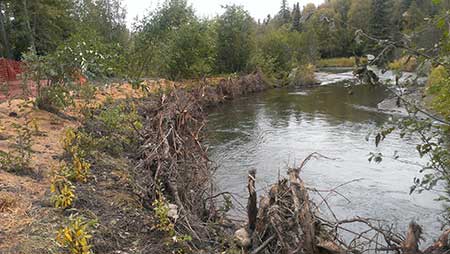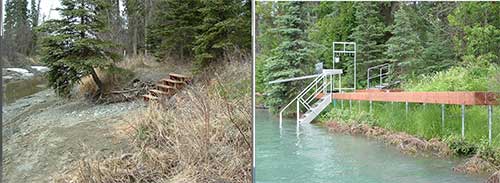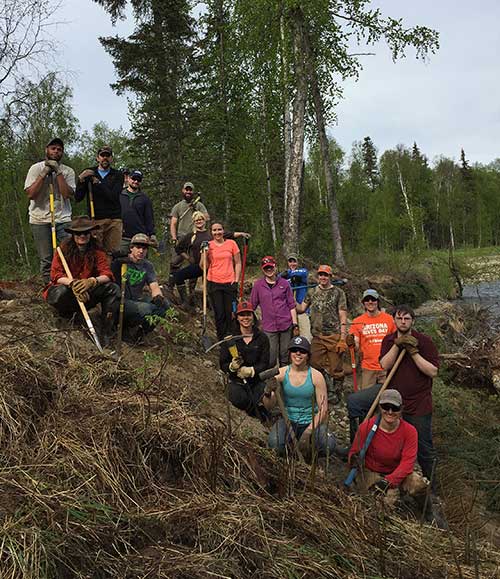Alaska Fish & Wildlife News
October 2015
Improving Fish and Wildlife Habitat
to Increase Salmon

Unstable, eroding riverbanks and debris-choked streams can be unfriendly to salmon. But unfriendly habitat can be improved, and over the past 20 years, more than 700 projects have been completed with the goal of increasing salmon.
The Habitat Restoration and Protection Cost Share Program, administered cooperatively by Alaska Department of Fish and Game (ADF&G) and the United States Fish and Wildlife Service (USFWS), provides private landowners and public land managers with technical expertise and funding for habitat restoration and protection projects along salmon stream and lakes in Anchorage, Fairbanks, the Kenai Peninsula and the Matanuska- Susitna Valley.
ADF&G partners with the USFWS, nonprofit organizations, local governments, and landowners to rehabilitate and sustain instream and riparian salmon habitat. Projects not only provide bank stabilization and rehabilitation, but also sustain or improve fish and wildlife habitat and increase salmon available to recreational, commercial and subsistence fisheries.
In 2014 the Cost Share Program partnered with the Municipality of Anchorage (MOA) Parks & Recreation to rehabilitate a heavily impacted section of streambank along Campbell Creek. This bend of Campbell Creek is paralleled by a paved multiuse trail that is utilized year round averaging over 51,012 trail users and 2,511 anglers per year. Due to degradation of riparian habitat between the trail and the creek, the streambank became unstable and began to erode.

This two-day field project involved the installation of 125-feet each of the following techniques: root wads, vegetative mat, and rooted alder and willow. Utilizing techniques outlined in the ADF&G Streambank revegetation and protection, a guide for Alaska manual. Trail work was completed by JTA Construction LLC and root wads installed by Moore’s Landscaping, both under contract with the (MOA) Parks & Recreation.
The Cost Share Program started in 1995, originally on the Kenai River. It expanded to include Fairbanks and the Matanuska-Susitna Valley in 2007, and to include Anchorage in 2011. Since 1995, more than 721 projects have been completed: 669 projects on the Kenai River, 28 projects in the Matanuska-Susitna Valley, 17 projects in Fairbanks and seven projects in Anchorage. To date, the program has removed 5,586 feet of detrimental structures; conserved 47,054 feet of habitat through the installation of light penetrating gratewalks, cabled spruce trees and exclusion fencing; rehabilitated 16,273 feet of fragile riparian and bank habitats; for a grand total of 63,327 feet of fish friendly habitat statewide.

Examples of past successful projects include, but are not limited to: bank stabilization techniques such as root wads, bio-engineered bank solutions such as trench willows and brush layers, and cabled spruce trees; protecting existing bank vegetation by constructing elevated light-penetrating gratewalks, and removing structures that are detrimental to salmon habitat, such as rock (riprap), jetties, bulkheads and other debris.
Educational outreach is a key component of the program, and staff conducts habitat rehabilitation workshops to a variety of participants including state and federal entities, local government, nonprofit organizations, private landowners, university students, and other interested parties. To date, 24 of these two day workshops have been presented across the state.

In 2015 we partnered with a private land owner along Willow Creek to conduct the field portion of our workshop. High water events in previous years significantly altered the shoreline leaving behind a highly erodible fine grained substrate with minimal vegetation.
This project involved the installation 200-feet Cabled Spruce Trees, 80-feet Trenched Willows, 20-feet Brush Layers (2 lifts), and 1000 square feet of Native Vegetative Materials and Live Staking. Originally the installation was scheduled for two days; however the incredible workshop participants hammered it out in one day!
For additional information on how to participate please visit our website. If you would like to meet with staff to discuss your project, please email Division of Sport Fish RTS Habitat Biologist Tracy Smith at tracy.smith@alaska.gov.
Subscribe to be notified about new issues
Receive a monthly notice about new issues and articles.
